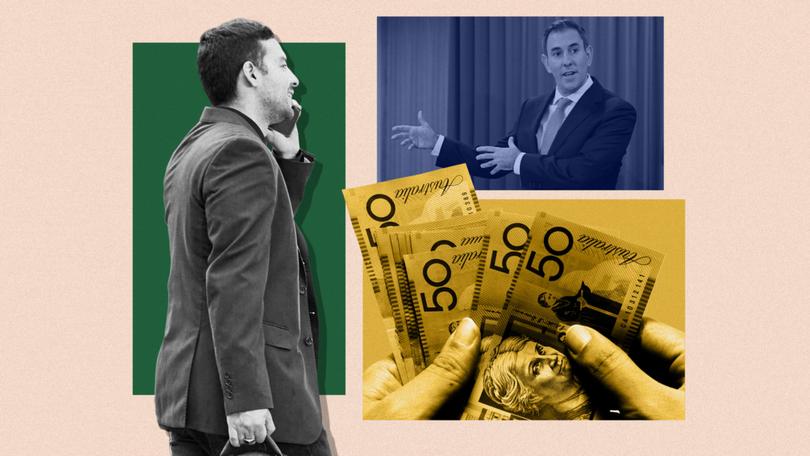Federal Budget 2024: Jim Chalmers banks on proven formula for busting inflation through cost-of-living cuts

Treasurer Jim Chalmers is banking on a proven formula for busting inflation in a bid to push it back to the Reserve Bank’s target range before the end of the year, in what would be a welcome Christmas gift for hundreds of thousands of Australians struggling under higher cost-of-living pressures.
The Budget details inflation to fall to 3.5 per cent by the end of next month and 2.75 per cent by the middle of next year, but also forecasts the RBA cash rate to only gradually ease from mid-2025.
The forecasts suggest three interest rate cuts in the space of a year, at a much slower and more drawn-out pace than some economists had suggested.
Sign up to The Nightly's newsletters.
Get the first look at the digital newspaper, curated daily stories and breaking headlines delivered to your inbox.
By continuing you agree to our Terms and Privacy Policy.“We can get on top of inflation without slashing and burning the Budget,” Dr Chalmers on Monday said.
“The Budget will put downward pressure on inflation.”
The RBA’s pre-Budget forecasts detailed last week suggest inflation would be at 3.8 per cent until the end of this year and not fall back to between 2 and 3 per cent – its target band – until late 2025.
The Budget details expectations the inflation rate will be brought down 0.5 percentage points through the 10 per cent bump in Commonwealth Rent Assistance and via a $300 energy bill relief package for all households – without adding to broader inflationary pressure. The Government also expects the Stage 3 tax cuts to lift disposable incomes – but is confident about its impact
“The Government’s decision to redesign tax relief through its cost-of-living tax cuts will provide relief to all 13.6 million taxpayers and will not impact the inflation outlook,” Budget papers state.
But economists say measures such as subsidies do not actually deliver on lower inflation, despite Government promises.
“Yes, the direct effects of subsidies reduce measured inflation. But because they add money into an economy still juggling inflation, the indirect effects add more to inflation than the direct effects to reduce it,” veteran economist and Budget watcher Chris Richardson said on Tuesday ahead of the Budget being handed down.
Mr Richardson argues subsidies merely add money available to be spent rather than lowering overall inflation.
The Government points to Bureau of Statistics figures showing childcare prices fell 7.2 per cent in 2023 compared to an increase of 13 per cent without the subsidies. The same occurred for electricity prices, which fell 12.9 percentage points from the June quarter of 2023 to March 2024, and to rents via Commonwealth Rent Assistance – down 1.7 percentage points over the year to March 2024.
The Commonwealth’s measures announced in the Budget come after a raft of cost-of-living measures in the Victorian and WA Budgets last week to support parents of school students and in further electricity bill relief, while the Queensland Government has also pledged similar measures.
Economists had also called for more targeted plans to enhance productivity growth, which has been lagging for many years. The Budget forecasts annual growth of 1.2 per cent “in the long run”.
“Weak productivity is also a reason why inflation is still too high,” HSBC chief economist Paul Bloxham said. “Policy measures ought to be focused on lifting productivity. At some point the luck of high commodity prices might run out.”
Others had called for greater fiscal discipline by cutting spending rather than solely banking revenue upgrades.
The Budget details spending “reprioritisations” and savings of just $27.9 billion, $3.1b in improving the tax system and another $1b in cutting back on external contractor spending by the public service.
It also warns of key risks to the outlook: more persistent price pressures if productivity does not lift as expected, leading to implications for unemployment; how household consumption will respond to stronger disposable incomes, and increased geopolitical tensions jeopardising commodity prices.
Treasury has forecast iron ore prices to gradually decline from current levels of just above $US110/tonne until the end of March next year and decline to $US60/t – a level not seen for several years.
Iron ore makes up about 18 per cent of Australia’s exports, so forecasts for a $US10/t uplift in prices are expected to add an extra $5.3b to the economy in 2024-25, and $500 million in tax receipts – and a decline of the same magnitude should prices slide $US10/t.
Elsewhere, the outlook is a little brighter for services inflation, expected to “gradually normalise” over the next two years from elevated levels – particularly for items such as insurance, which in the year to March had its highest increase in two decades.
Rents have also been a major contributor to higher inflation, with advertised prices over the year to April increasing more than 8 per cent. While this is expected to remain elevated, Treasury expects rent pressures to gradually ease – in some part due to the forecast halving of net overseas migration to 260,000 next financial year.
